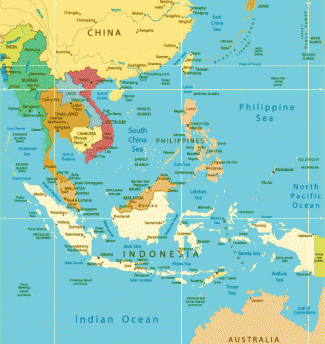
“Europe is a landscape; East Asia a seascape. Therein lies a crucial difference between the twentieth and twenty-first centuries.”
~ Robert D. Kaplan
By Catherine Austin Fitts
We hear it and read it often in the news: we are shifting from a unipolar to a multipolar world. What does that really mean?
One aspect is the rise of Asia’s economy as a percentage of global GDP. With it, we are witnessing the rising importance of the South China Sea. To learn more, I just finished two books published in 2014:
- Asia’s Cauldron: The South China Sea and the End of a Stable Pacific by Robert D. Kaplan, chief geopolitical analyst for Stratfor and foreign correspondent for The Atlantic.
- The South China Sea: The Struggle for Power in Asia by Bill Hayton, a reporter for the BBC.
Asia’s Cauldron is shorter and an easier read for the busy professional. It communicates a marvelous appreciation for the geography involved — something often associated with the folks at Stratfor — as well as an appreciation for the many distinct cultures and countries located in and adjacent to the South China Sea.
The South China Sea was named a book of the year by The Economist. Bill Hayton provides more history as well as greater detail on current events. I found it particularly useful to read both these books in conjunction with Asia’s Space Race by Dr. James Clay Moltz.
So why is the South China Sea so important? Here is where Kaplan begins:
“The South China Sea functions as the throat of the Western Pacific and Indian oceans — the mass of connective economic tissue where global sea routes coalesce….More than half of the world’s annual merchant fleet tonnage passes through the choke points, and a third of all maritime traffic worldwide. The oil transported through the Malacca Strait from the Indian Ocean, en route to Asia through the South China Sea, is triple the amount that passes through the Suez Canal and fifteen times the amount that transits the Panama Canal. Roughly two thirds of South Korea’s energy supplies, nearly 60 percent of Japan’s and Taiwan’s energy supplies, and 80 percent of China’s crude oil imports come through the South China Sea.”
The South China Sea is more than critically important shipping lanes. According to Kaplan, “South China Sea fish stocks may account for as much as one tenth of the global landed catch.” In addition, tensions continue over disputes related to historic claims to three archipelagos: the Pratas, the Parcles and the Spratyls. China is building artificial islands and, as they continue to build their Navy, extending their claims to territory and jurisdiction. In addition, there are hydrocarbon reserves and various other natural resources to be tapped.
Both Kaplan and Hayton agree that China’s naval power is currently no match for the US Asian fleet — a welcome fact for East Asian nations concerned with a rising China. However, short of a domestic economic collapse in China, the authors foresee a change in the balance of power approaching. That is important: a change in the balance of power in the South China Sea will send ripples through the balance of worldwide power and throughout the global financial system.
As Hayton neatly states, “The South China Sea is where China’s rising ambitions meet the United States’ global primacy. It is also the arena in which Southeast Asia will define its relations with its giant neighbour.”
As you watch the US Dollar Index rise and fall and emerging markets struggle with US dollar denominated debt, remember that dominance of the seas has for centuries been a condition precedent to a global reserve currency.


